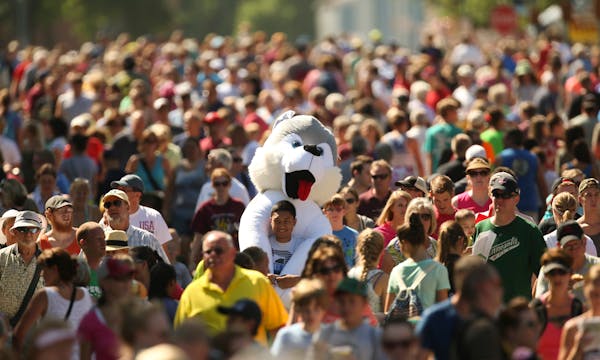Listen and subscribe to our podcast: Via Apple Podcasts | Spotify | Stitcher
Picture this: You're on a Minnesota road trip, minding your own business and having a good time, when you see a sign for Climax. Or maybe one for Nimrod, Embarrass or Fertile. Who named these towns? And more importantly, why?
That's the latest question for Curious Minnesota, our community-driven reporting project fueled by questions from inquisitive readers.
We rounded up 11 of the state's most head-scratching town names, and discovered how they came to be.
Nimrod
You can just imagine the quips that follow after you tell someone you're from a town called Nimrod. While most people probably think of the word as a synonym for "idiot," the real origin is quite the opposite. This tiny community is really named after the biblical figure Nimrod, who appears in the Book of Genesis. Nimrod is described as a "mighty man" and a "mighty hunter before the Lord," descriptions that might have appealed to the pioneers who settled the area.
Sleepy Eye
This town is named after Chief Sleepy Eye, a Dakota leader who lived in the area during the 1850s. He had a medical condition that gave him heavy eyelids, and his indigenous name was "Ish-Tak-ha-ba," which translates to sleepy eyes. He was known for his skilled, peaceful diplomacy.
"I would assume the early settlers saw a lot of dignity in that, and assumed it would be appropriate to name our town after that," said Christina Andres, executive director for the Chamber of Commerce and Convention and visitors bureau in Sleepy Eye.
Today, a statue and granite obelisk stand in the town, honoring his memory.
Climax
This community was named after a brand of chewing tobacco back in 1896. If you happen to meet someone from this little town of just under 300, keep the jokes to yourself, they've heard them all.
Little Canada
You would never be able to guess that the fur traders who named the town were French Canadian. The original name was actually Petit Canada, and when the first school was established in 1850 classes were taught in French. The citizens of Little Canada are very fond of their roots, and hold an annual Canada Days community celebration. Representatives from their sister city Thunder Bay, Ontario, are always invited.
New Prague
Unsurprisingly, New Prague was established by Czech immigrants, although over the years the pronunciation has become "New PRAY-ge." The town still honors its heritage, and you can find several restaurants serving up traditional Czech food.
Embarrass
Early French explorers were so frustrated by how difficult it was to travel this area by canoe that they named it the Embarrass River (the town name came later). It comes from the French verb embarrasser, which means to embarrass or to be put in an awkward position.
Savage
The town of Savage was originally named Hamilton, until residents were swept off their feet by a local celebrity. In 1902, wealthy Minneapolis businessman Marion Willis Savage purchased a plot of land in the town, and soon after purchased the Standardbred pacer Dan Patch, who went on to break the world record in the mile at the 1906 Minnesota State Fair.
"At the time he was one of the most famous athletes in the world," said Emily Gunderson, City of Savage communications manager.
If you haven't figured it out by now, the real celebrity was the horse, although the town bears the name of the human who brought residents their beloved Dan Patch.
In 1916, both the horse and owner became ill, and Savage died just one day after Dan Patch did.
"The claim is that he died of a broken heart, or the shock of losing his beloved horse," Gunderson said.
The city of Savage is still pretty enamored with the dynamic duo, and in 2018 it erected a statue of man and horse in front of the public library.
Winner
This one is actually a ghost town, so it looks like they pulled the trigger a bit too early with the name.
Fertile
Minnesota settler John LaDue migrated to Polk County from Fertile, Iowa, and thought the land looked so similar to his hometown that he decided to name the new settlement after it.
A more recent fun fact: Fertile was just named the nicest place in Minnesota by Reader's Digest.
Clam Falls
Native Americans named the river in this area Kenesca-Seba, or Clam Shell River, and the falls were dubbed Cobbekonta, or Little Falls. In the early 1870s, white settlers established a village in the area and dubbed it Clam Falls.
Nowthen
This community was named by accident. Before Nowthen was a town, it was part of the unincorporated area known as Burns Township. Their first postmaster, Jim Hare, wrote to the Post Department requesting to establish the Burns Post Office, but his application was rejected because it was too similar to the Burnstown Township Post Office. Hare had a habit of starting and ending his sentences with "nowthen." So when he suggested several new names and ended his letter with "nowthen" they mistook it as a suggestion. Thus the Nowthen Post Office, and eventually the city of Nowthen was born.
---
If you'd like to submit a Curious Minnesota question, fill out the form below:
Read more Curious Minnesota stories:
How did the Twin Cities become a hub for Somali immigrants?
Why was Minneapolis' mansion street destroyed, but St. Paul's survived?
Why won't anyone in Minnesota take the last piece of food?
Is Minnesota's tiny Lake Itasca the true source of the Mississippi River?
Why isn't Isle Royale a part of Minnesota?
Why is Uptown south of downtown in Minneapolis?
Why can't Minnesotans figure out how to zipper merge?
What percentage of Minnesotans spend their entire lives here?
How did Minnesota's indigenous people survive the extreme winters?





